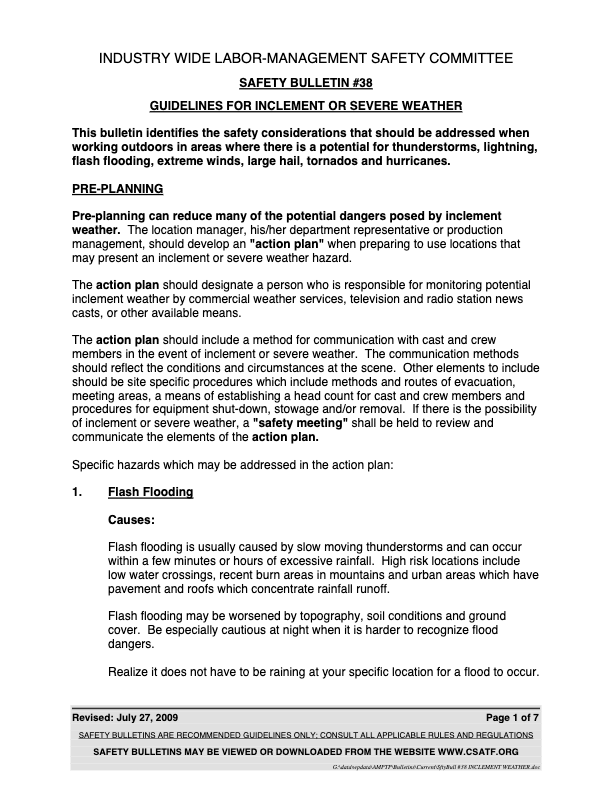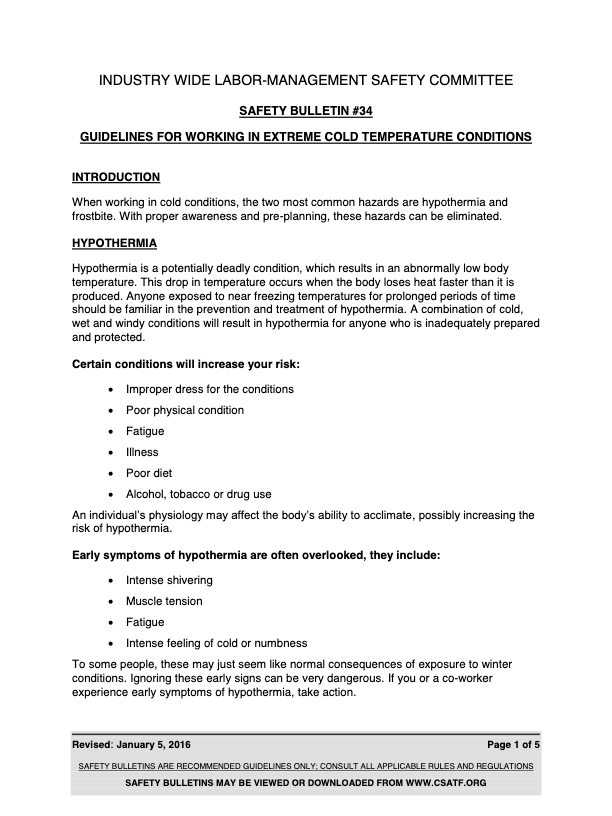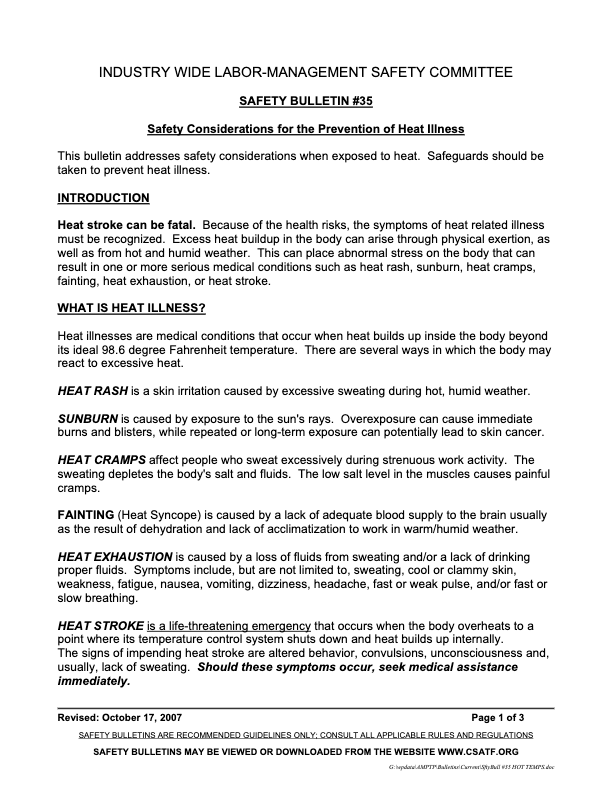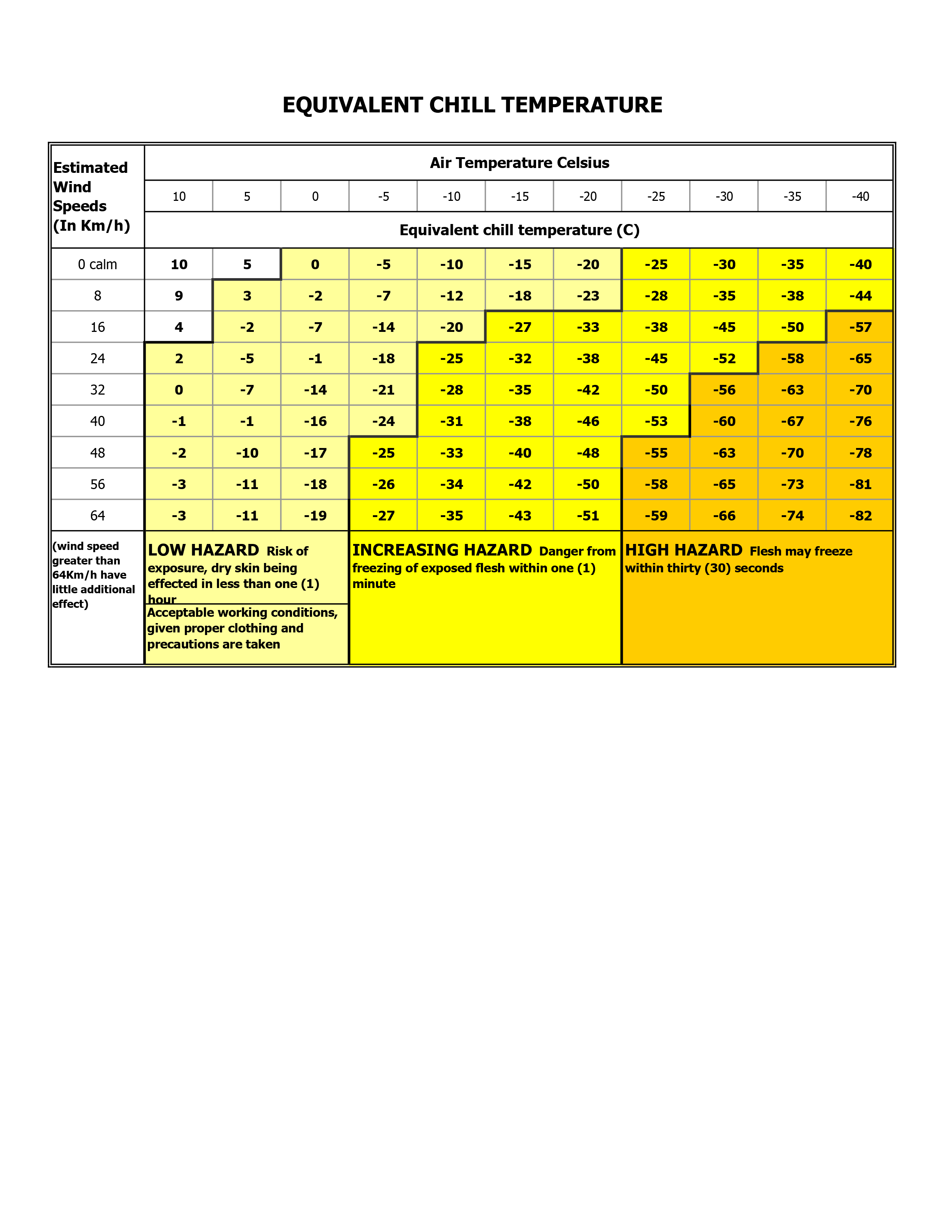Safety Bulletin

Guidelines
This bulletin identifies the safety considerations that should be addressed when working outdoors in areas where there is a potential for thunderstorms, lightning, flash flooding, extreme winds, large hail, tornados and hurricanes.
Pre-Planning
Pre-planning can reduce many of the potential dangers posed by inclement weather. The location manager, his/her department representative or production management, should develop an “action plan” when preparing to use locations that may present an inclement or severe weather hazard.
The action plan should designate a person who is responsible for monitoring potential inclement weather by commercial weather services, television and radio station news casts, or other available means.
The action plan should include a method for communication with cast and crew members in the event of inclement or severe weather. The communication methods should reflect the conditions and circumstances at the scene. Other elements to include should be site specific procedures which include methods and routes of evacuation, meeting areas, a means of establishing a head count for cast and crew members and procedures for equipment shut-down, stowage and/or removal. If there is the possibility of inclement or severe weather, a safety meeting shall be held to review and communicate the elements of the action plan.
Specific hazards which may be addressed in the action plan:
Flash Flooding
Causes:
Flash flooding is usually caused by slow moving thunderstorms and can occur within a few minutes or hours of excessive rainfall. High risk locations include low water crossings, recent burn areas in mountains and urban areas which have pavement and roofs which concentrate rainfall runoff.
Flash flooding may be worsened by topography, soil conditions and ground cover. Be especially cautious at night when it is harder to recognize flood dangers.
Realize it does not have to be raining at your specific location for a flood to occur.
Potential Hazards:
- Crew and equipment could become trapped or stranded as escape routes may be damaged and/or blocked.
- Equipment and personnel could be swept away or covered by water, mud or debris.
- Drowning
- Electrocution
- Mud slides
Possible Actions:
- Activate the action plan.
- Secure equipment and all electrical power.
- Remove all cast and crew from elevated equipment, scaffolds, booms and sets.
- Stay clear of potential slide areas next to hillsides or on edges of cliff areas.
- Follow directions for evacuation procedures as outlined in the action plan.
- Gather at pre-determined evacuation point and ensure everyone is accounted for.
- If you come upon a flowing stream where water is above ankles, STOP! Turn around and go another way.
- Do not drive through moving water or a flooded roadway.
- Do not attempt to return to the area until an “all clear” signal has been given by a regulatory authority or production management.
Lightning
Causes:
Lightning results from the buildup and discharge of electrical energy in clouds. Lightning may strike several miles from an associated thunderstorm and may strike when no clouds or rain are present.
Potential Hazards:
- Electrocution
- Burns
- Falling debris
- Concussion
- Fire
Possible Actions:
- Activate the action plan
- When working in lightning prone areas, the use of a lightning detector/meter is highly recommended. If a meter is not available, it is possible to estimate the distance of lightning by the thunder. When lightning is seen, count the seconds until thunder is heard and then divide the seconds counted by five to obtain the approximate distance in miles.
- 30-30 rule: The first 30 means if you count to 30 seconds or less (from lightning to thunder), the lightning is within 6 miles of your location and you are in potential danger and should seek shelter. The second 30 means you should wait 30 minutes from the last flash or thunder to establish an “all clear.”
- Seek shelter in a sturdy building, a hardtop automobile or truck with the windows rolled up. If such cover is not available seek shelter in wooded areas with thick small trees. Avoid isolated trees.
- Avoid high ground and keep clear of tall objects, towers, aerial lifts, camera booms, scaffolding, fences or other metal equipment.
- Avoid contact with any body of water.
- Avoid using a telephone or cellular phone.
- Where appropriate, shut down generators in accordance with the established action plan.
- Avoid using other electrical equipment or appliances.
- When instructed, move to the pre-determined evacuation area.
- Do not attempt to return to the area until an “all clear” signal has been given by a regulatory authority and/or production management or 30 minutes after the last thunder sound is heard.
High Winds
Causes:
High winds can be associated with extreme weather phenomenon including thunderstorms, tornados, hurricanes, and high and low pressure systems. During the summer months in the Western States, thunderstorms often produce little rain but very strong wind gusts (some up to 100 mph) and dust storms.
Potential Hazards:
- Flying debris
- Dust
- Possibility of persons being swept off their feet
- Equipment can be blown over and carried for a distance
- Set destruction
- Eye injuries
Possible Actions:
- Activate the action plan
- Remove all cast and crew from elevated areas, sets, scaffolding and other high objects
- Lower all aerial, lighting, diffusion, camera boom equipment and tents
- Tie down and secure all loose equipment
- When instructed, seek refuge from the winds at your pre-determined safe area
- Be aware and protect your eyes from potential injury
- Do not attempt to return to the area until an “all clear” signal has been given by a regulatory authority or production management
Large Hail
Causes:
Hail is usually associated with thunderstorms and is caused by freezing rain that can become very large.
Potential Hazards:
- May cause injuries to crew and damage to equipment
Possible Actions:
- If a watch or warning has been issued, the action plan should be activated and the crew should follow all instructions
- Secure and protect all equipment
- Get down from elevated areas, aerial lifts, booms, scaffold and other high areas
- When instructed, seek shelter at your pre-determined safe area
- Do not attempt to return to the area until an “all clear” signal has been given by a regulatory authority or production management
Blizzard or Severe Snow Storms
Causes:
A storm accompanied by strong winds creating blizzard conditions with blinding wind-driven snow, severe drifting and dangerous wind chill.
Potential Hazards:
- Blinding conditions
- Creation of snow drifts
- Dangerous wind chill factor
- Avalanche danger, being caught and/or buried
- Usually triggered by victim or members of victims party
- Generally occur with clear skies, little or no snow fall and light or calm winds
- The weak layer often consists of surface hoar, facets or depth hoar
- On 30-40 degree slopes, often at a convex part of the slope
Possible Actions:
- If a watch or warning has been issued, the action plan should be activated and the crew should follow all instructions
- Secure and protect all equipment
- Get down from elevated areas, aerial lifts, booms, scaffold and other high areas
- Stay clear from potential avalanche areas
- When instructed, seek shelter at your pre-determined safe area
- Do not attempt to return to the area until an “all clear” signal has been given by a regulatory authority or production management
Tornados
Causes:
A tornado is a violent windstorm characterized by twisting, funnel-shaped wind. Tornados tend to occur in the afternoon and evening hours.
Potential Hazards:
- Tornados are unpredictable and may form without warning
- Winds can exceed 200 to 300 mph
- Tornados may appear nearly transparent until dust and debris are picked up or a cloud forms within the funnel
- Severe damage can occur to structures
- The precise location of a touch down point cannot be determined
Possible Actions:
- If a watch or warning has been issued, the action plan should be activated
- The crew should be regularly updated regarding any changes to potential weather conditions
- All cast and crew members must follow all instructions given
- No employees should be working on elevated equipment. This includes aerial lifts, scaffolds, camera booms, and other high areas
- Evacuate the area immediately if instructed by a regulatory authority or production management
- Only secure equipment if there is time and it can be done safely
- Do not attempt to return to the area until an all clear signal has been given by a regulatory authority or production management
Hurricanes
Causes:
A slow developing tropical weather phenomenon that forms over water. Its greatest impacts are felt near or on shorelines of land. You will not be surprised by a hurricane, as they are usually tracked by a weather service for many days. They are also known as cyclones or typhoons.
Potential Hazards:
- Severe winds and rainfall, which may cause extreme flooding
- Storm surges
- High waves possibility of persons being swept off their feet
- Drowning
- Localized tornados
- Extreme damage to structures, roads, utilities, vehicles and boats
- Severe injury due to flying debris
Possible Actions:
- In most cases, you will have several days warning to activate your action plan
- Do not stay by shoreline
- Pack and secure all equipment and remove to a safe area
- Lower all aerial lifts, camera booms and other equipment. Remove to a safe area as time permits
- If ordered to evacuate, leave area early — do not hesitate
- Do not attempt to return to the area until an “all clear” signal has been given by a regulatory authority or production management
Additional Notes
- OSHA mandates that aerial lifts and other like equipment are not to be operated when winds exceed 25 mph.
- Be aware that many of the same precautions (e.g., eye protection and securing equipment), can also apply to man-made wind effects such as rotor wash from airplanes or helicopters and large ritter fans.



